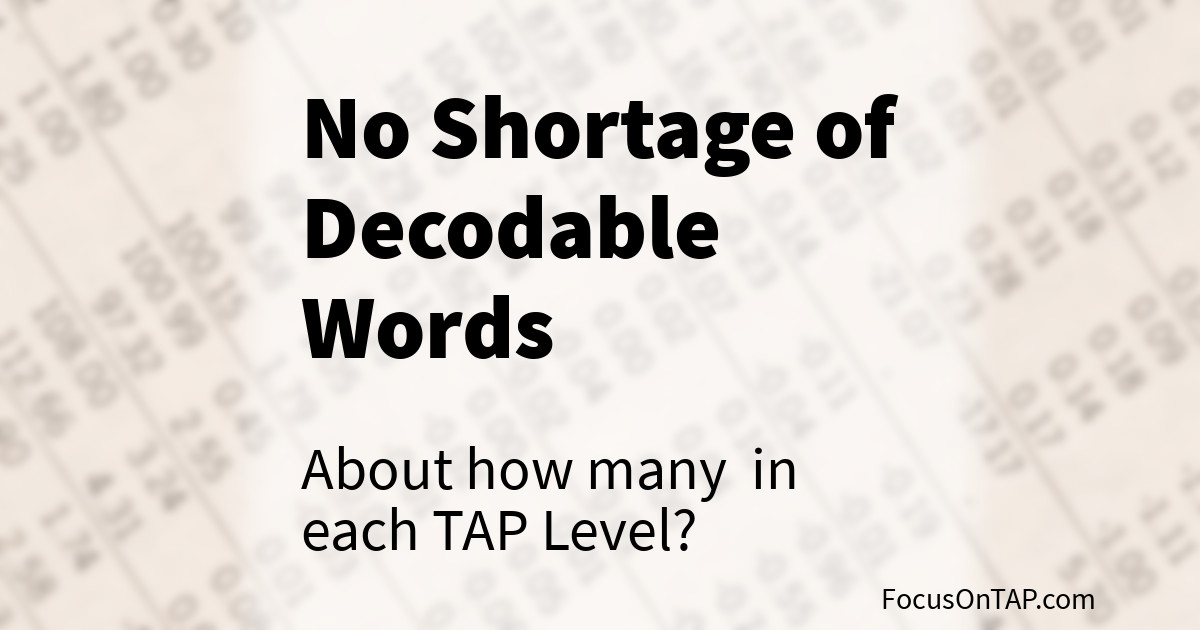We recently made available online a free beta version of the decodability analysis tool that we use to guide us in editing our manuscripts. Yesterday, we made some adjustments to the higher phonics levels of our decodable books and this meant an update to the tool. As I generated a new lookup table* based on the adjusted contents of the upper levels, I was noticing that there is no shortage of fully decodable words even at level 1 (CVC and VC; also CCVC and CVCC where each consonant contributes a sound, so no digraphs).
This is not news to anyone who teaches reading and spelling using phonics, but I thought it might be interesting to share the distribution of words over the levels. I should point out that this count is not exhaustive. I’m not saying, for example, that there are exactly 899 TAP level 1 decodable words in English but rather that our list currently contains that many. That being said, 899 is a lot!
Number of Decodable Words per Level
As of version 1.1 of the tool, the number of words in the decodability tool’s lookup table in each level is as follows (with a few example words):
- Level 1: 899 ( at, flip, pill )
- Level 2: 832 ( thin, sick, song )
- Level 3: 4108 ( date, itself, impute )
- Level 4: 4300 ( swamped, children, softball )
- Level 5: 2668 ( real, knead, arrow )
- Level 6: 8977 ( felines, biomass, babble )
- Level 7: 2078 ( judgeships, recent, saucer )
- Morph Level: 722 ( caution, vision )
Or if you’d prefer a running tally, it looks like this
- Level 1: 899
- + Level 2: 1,731
- + Level 3: 5,839
- + Level 4: 10,139
- + Level 5: 12,807
- + Level 6: 21,784
- + Level 7: 23,862
- + Level M: 24,584
Percentage of the 10,000 Most Frequent Words
Just for fun, here’s the percentage at each level of the 10,000 most frequent English-language words (excluding swear words 🙁 ) used on the Internet according to Google circa 2016 and in parentheses the percentage of the 1000 most frequent of those:
- Level 1: 4.5% ( 9.5% )
- + Level 2: 6.8% ( 13.3% )
- + Level 3: 14.5% ( 22.6% )
- + Level 4: 21% ( 30.3% )
- + Level 5: 26.3% ( 36.4% )
- + Level 6: 41.7% ( 55.5% )
- + Level 7: 46% ( 60.2%)
- + Level M: 48% ( 61.5% )
Conclusion
OK, admittedly that’s a lot of numbers for a post about decodable words. The take home here is that the English lexicon of decodable words is sizeable and rich. By level 3 (where we allow the split digraph known as “silent e”), we see that learners have decodable access to fully a quarter of the 1,000 most frequent words and nearly 6,000 words if we let ourselves use “fancier” words like scrappy!
We take advantage of that rich lexicon to create interesting, age-appropriate digital phonics readers for teenagers and adults. Curious? The TAP Library iPad app is free to download and samples of all our phonics books are included. Click/tap here to go to the app page in the App Store. (BTW, it’s crazy, but the link doesn’t work if you’re reading this on an iPhone, because the app is iPad only.)
Lists of Decodable Words
This post was really just to whet your appetite for decodable words. It’s only natural to want to see these words and that’s what I’ll focus on in my next few posts: a list of decodable words at each of the low TAP phonics levels starting with this list of level 1 decodable words. More than just a list, however, I want to give people tools for exploring and mining these rich, fully decodable sets of words.
*I wrote a blog post announcing the availability of this tool that has more details on how the decodability analysis tool works.
